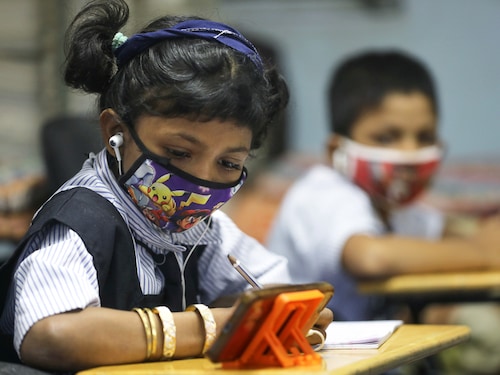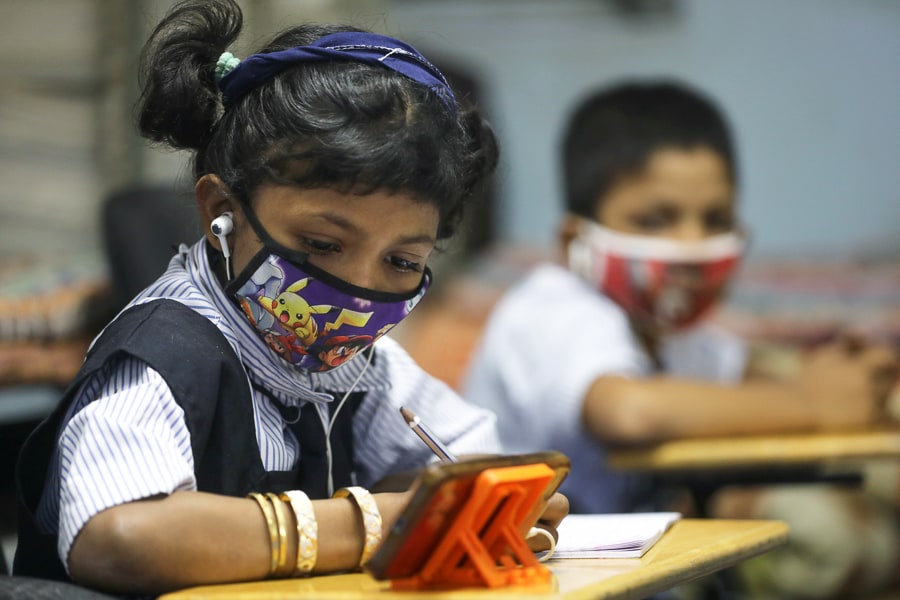Budget 2022: Education gets a digital push
Finance Minister Nirmala Sitharaman acknowledges the impact of Covid on the sector and increases allotment from Rs93,224 crore in FY22 to Rs104,277.72 crore in FY23


 The increase in allotment comes from the acknowledgment that education has been deeply impacted by the Covid-19 pandemic, with children and youth of rural India bearing the biggest brunt
The increase in allotment comes from the acknowledgment that education has been deeply impacted by the Covid-19 pandemic, with children and youth of rural India bearing the biggest brunt
Image: Francis Mascarenhas / Reuters
Nirmala Sitharaman, in her fourth Union Budget presentation, tabled a record Rs104,277.72 crore for expenditure on education for FY23. This is Rs11,053.41 crore more than the Budget estimate of Rs93,224 crore for FY22 and translates to nearly 12 percent growth compared to last year.
The increase in allotment comes from the acknowledgment that education has been deeply impacted by the Covid-19 pandemic, with children and youth of rural India bearing the biggest brunt. The rise in allocation for the education sector owes to the jump in the amount earmarked for Samagra Shiksha (school education sector)—from Rs31,050 crore in 2021-22 to Rs37,383 crore in 2022-23, and a higher requirement for Kendriya Vidyalaya Sangathan, Navodaya Vidyalaya Samiti, World Class Institutions, Grants to Central Universities, National Institute of Technology and Indian Institute of Engineering Science and Technology (IIEST).
“Due to the pandemic-induced closure of schools, our children, particularly in the rural areas, and those from Scheduled Castes and Scheduled Tribes, and other weaker sections, have lost almost two years of formal education," Sitharaman said. “We recognise the need to impart supplementary teaching and to build a resilient mechanism for education delivery."
To this regard, the PM eViIDYA programme—launched in 2020, it provides access to ‘quality education" to students who do not have access to the internet—that initially encompassed 12 one class-one TV channels will be expanded to 200 channels to enable all states to provide supplementary education in regional languages for classes 1 to 12.
The move comes in the light of the fact that only 4 percent of India’s population in rural areas has access to computers compared to 23 percent in urban areas, as per NSO Report on Education, 2020. Approximately 1.5 million schools and 1.4 million ECD/Anganwadi centres were closed due to the pandemic. According to Unicef’s study, consequently, nearly 247 million children could not go to school for more than a year.
“The availability of regional language educational modules from Class 1 to 12 will enhance the literacy rates in India’s hinterlands, over and above the metro cities. This will serve as the driver of socioeconomic change, enabled through technology. Education specifically has taken a new direction that has made technology-based learning, whether online or blended, indispensable for our education systems. Digital learning holds the potential to empower the country’s grassroots-level population through democratised access to education, thereby facilitating continued learning sans infrastructural challenges, pan-India," says Ujjwal Singh, CEO, and president, Infinity Learn, an entrance exam preparation platform.
Presenting her second digital budget, Sitharaman emphasised the need to make educational tools available and accessible to a wider student base. “High-quality e-content in all spoken languages will be developed for delivery via internet, mobile phones, TV, and radio through digital teachers," she said.
Keeping in mind the need to empower and equip teachers with digital tools of teaching to facilitate better learning outcomes, a competitive mechanism for the development of quality e-content by the teachers will be set up. “The focus on teachers’ training through higher allocation will aid the effective implementation of new initiatives in the Budget. However, in India, it"s about better coordination with states because union money is only a part of overall education spend," says Sandeep Wirkhare, MD & CEO, Indian School Finance Company.
Though the allocation is up, there was no reference to the New Education Policy, 2020, or how the changes recommended there would be implemented. But in keeping with its ideology of creating a better digital educational ecosystem, Sitharaman announced the setting up of a digital university that would provide access to quality universal education with a personalised learning experience spreading pan-India. This will be made available in different Indian languages and ICT formats, thus expanding the access for the Indian students. “The university will be built on a networked hub-spoke model, with the hub building cutting-edge ICT expertise. The best public universities and institutions in the country will collaborate as a network of hub-spokes," she said.
Another major highlight of the budget is allowing foreign universities and institutions under GIFT IFSC to offer courses on fintech, science, technology, engineering, and mathematics. “Allowing world-class universities to offer courses free from domestic regulations will be great for students as this would make such education more accessible and affordable," says Prateek Bhargava, founder & CEO, Mindler, an educational consultant agency.
Three schemes under the Ministry of Women & Child Development—Mission Shakti, Mission Vatsalya, Saksham Anganwadi, and Poshan 2.0—were launched recently to provide integrated benefits to women and children. Saksham Anganwadis are a new generation of anganwadis that have better infrastructure and audio-visual aids, powered by clean energy and providing an improved environment for early child development. Two lakh anganwadis will be upgraded under the scheme.
“Early childhood education forms the foundation for a child"s learning and is integral to their holistic development. The transformation of two lakh Anganwadi centres under Saksham Anganwadis will make these centres more learning-conducive for children. Often neglected in rural parts of the country, this is a positive step towards promoting early childhood education for children and equipping them better for school," says Anil Parmar, vice president, community investment, United Way Mumbai, a non-profit organisation working in urban and rural communities across India to identify and implement solutions to different community problems.
For vocational courses, as a means to promote crucial critical thinking skills, to give space for creativity, 750 virtual labs in science and mathematics, and 75 skilling e-labs for a simulated learning environment, will be set up in 2022-23.
Rishikesh BS, who leads the Hub for Education, Law, and Policy at Azim Premji University, says that in one line, for any educationist, the focus on education was "disappointing, but not surprising at all". According to him, "There is over-emphasis on digital solutions when we have seen that is of very little use even if you have the required digital infrastructure in place. Misplaced priorities."
Maneesh Dhooper, co-founder, PlanetSpark, says, “The focus on the growth of Digital India through various schemes and new initiatives will not only boost the parallel growth of digital learning but will also encourage edtech companies to streamline their curricula in accordance with the country"s growing inclination towards building a digital economy. It is 2022 and Indians needs to match pace with the massive digitisation that has been already adopted across sectors, across economies, and this year"s Union Budget certainly reflects the government"s vision of a Digital India."
“We believe that with the future of education being hybrid, edtech companies can be great allies of the government and the education ecosystem as a whole. Technological innovations can magnify government spending by a factor of ten and speed up the implementation of NEP goals, including tracking and improving students" learning outcomes and overall progress. The goal is to upskill students in all aspects of their lives through innovative and creative courses," says Mohit Marwah, co-founder, AAFT Asian Academy of Film & Television, online.
For Nitish Jain, president, SP Jain School of Global Management, the Budget is headed in the right path by focusing on improving the digital infrastructure in the country. “Moving ahead, the execution, and how quickly these things move will be the most important factors to watch. Education is what propels the economy and the country forward, and I am confident that Budget 2022 will go a long way toward ensuring that education remains at the top of our country"s priorities," he says.
Additional inputs by Divya Shekhar
First Published: Feb 01, 2022, 18:48
Subscribe Now